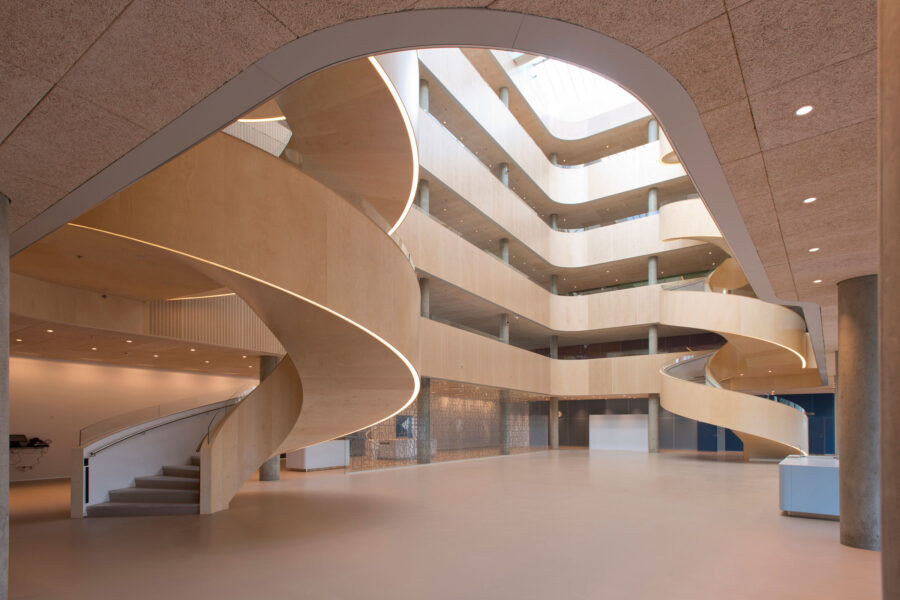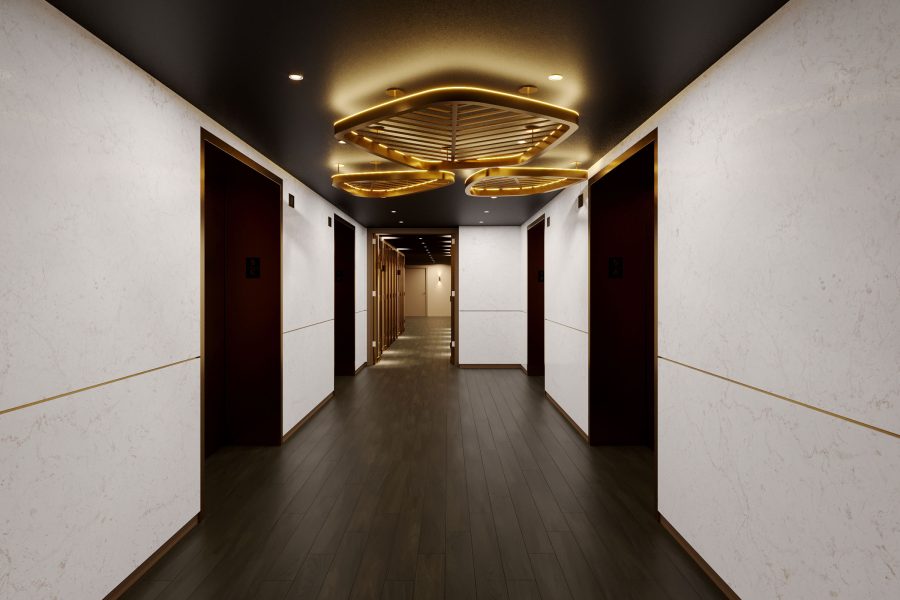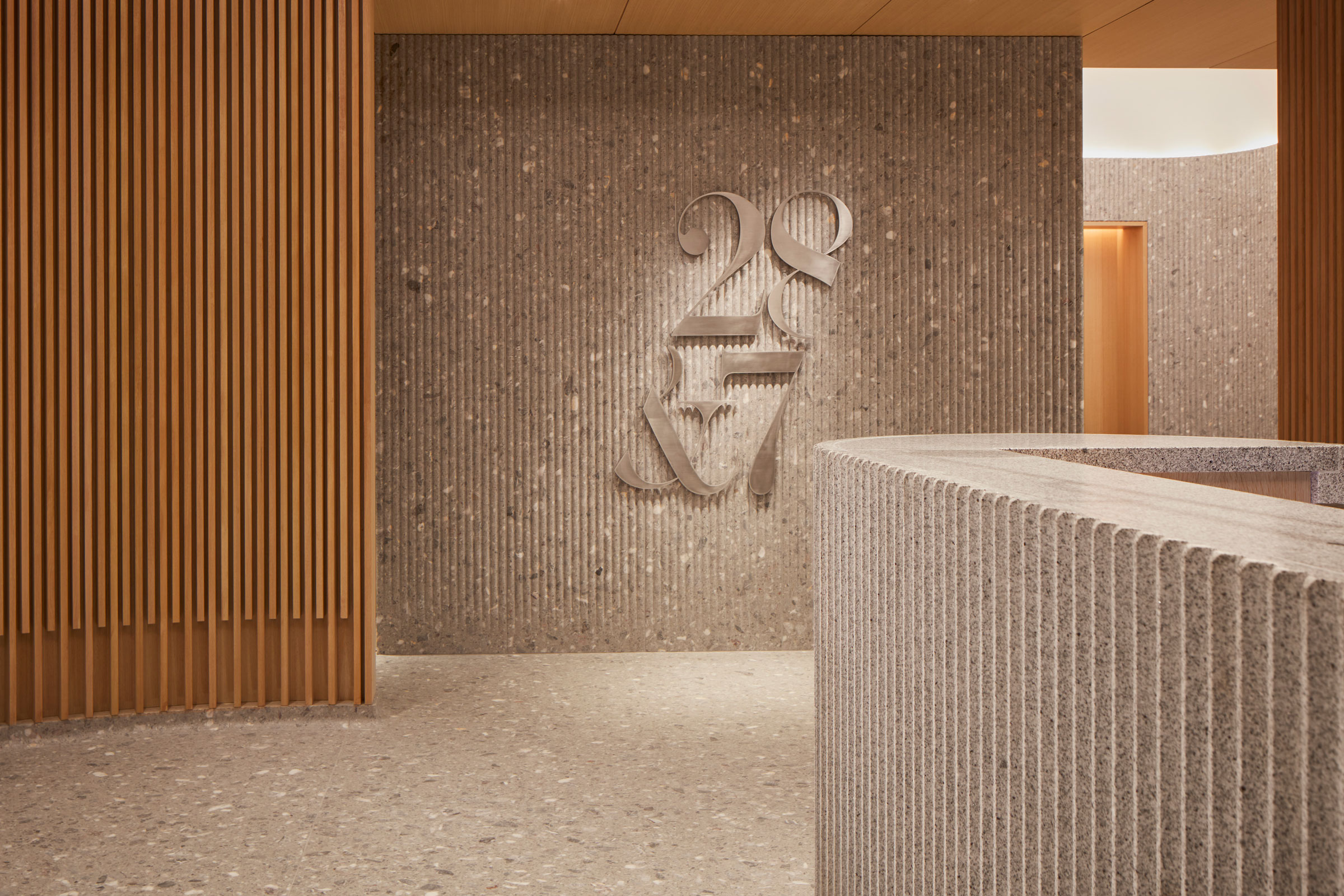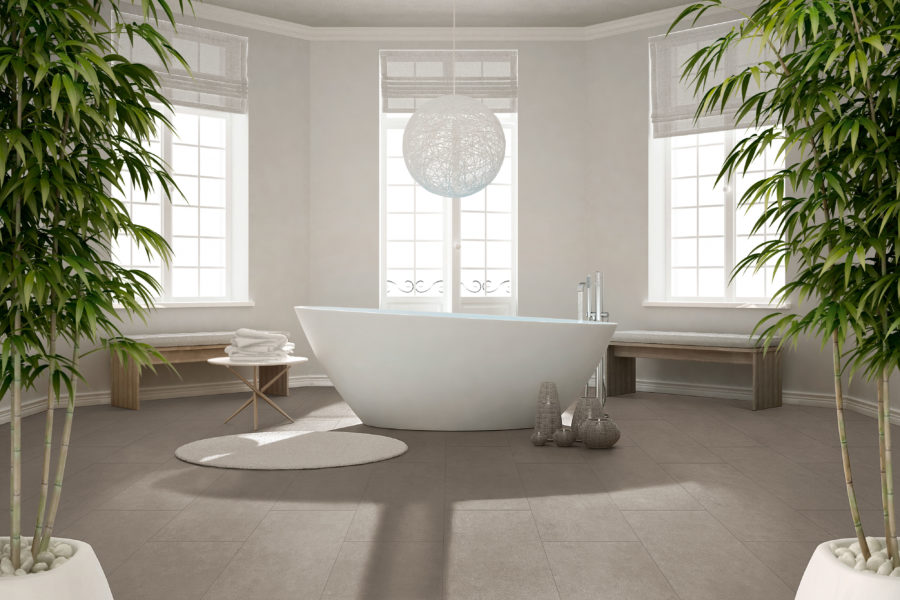Story at a glance:
- Eco-friendly flooring is typically made from renewable materials, recycled materials, low-carbon materials, or some combination of the three.
- Bamboo and cork flooring, like ethically sourced hardwood flooring, are favored for their ability to sequester carbon throughout their lifespans.
- Porcelain tile, stone, and terrazzo flooring are considered eco-friendly because of their extreme durability, long lifespans, and recyclability.
Flooring makes up a large percentage of any building’s interior surface space, and yet it’s often under-appreciated. Flooring must be capable of withstanding constant wear and tear while also being aesthetically pleasing.
Considering the amount of flooring options currently on the market, it’s not hard to find something that checks all of those boxes, but as the demand for sustainable design grows, it’s important to consider the environmental impact of every product used.
Whether you’re looking to replace existing flooring with a sustainable alternative or trying to decide which flooring is right for a project, the following guide provides a comprehensive overview of the most common eco-friendly flooring options.
What is Eco-Friendly Flooring?
Eco-friendly flooring is typically categorized as any flooring produced primarily using natural, low-carbon, and/or recycled materials. Eco-friendly flooring, like any sustainable product, is designed to have the lowest possible environmental impact over the course of its lifespan. This starts with how the flooring’s materials are sourced and ends with how the material is disposed of.
Most eco-friendly flooring solutions prioritize renewable materials capable of being harvested with minimal emissions, existing materials that would otherwise end up in landfills, and materials that can be recycled, repurposed, or composted.
Types of Eco-Friendly Flooring
Where the choices for eco-friendly flooring used to essentially be limited to hardwood, stone, and porcelain or ceramic tile, today there are a plethora of sustainable, environmentally conscious options to choose from available in a wide range of aesthetic styles.
Resinous Flooring

SofTop resinous flooring is seamless, sanitary, and easy to clean and has sound dampening benefits for a better indoor experience. Photo courtesy of Sherwin-Williams
Also referred to as epoxy or seamless flooring, resinous flooring is a smooth, non-porous coating that is poured as a liquid over an existing substrate—typically a concrete slab—and left to harden into a solid, plastic-like surface. The most common types of resins used in these flooring systems are epoxy, methyl methacrylate, and polyurethane, all of which share similar performance characteristics.
Naturally chemical resistant, stain resistant, and durable, resinous floorings can, when properly cared for, last upwards of 10 years.
“Of all the choices for flooring, this is the one that stays with the building,” Philip C. Smith, market segment manager at Sherwin-Williams, told gb&d in a previous publication. “It penetrates the surface, bonding to the concrete, almost becoming part of the slab. If you want to do something different in the future you don’t have to tear this out and put it in a landfill. You can build on top of it, which is potentially a more sustainable option, and that’s important.”
A leading manufacturer of paints and coatings, Sherwin-Williams carries a wide range of resinous floor solutions. The company’s SofTop Comfort resinous flooring, for example, is a seamless fluid-applied elastomeric flooring that feels soft underfoot but still offers high durability and chemical resistance, making it an ideal choice for health care, education, hospitality, and other commercial and industrial settings.
In line with Sherwin-Williams’ commitment to sustainability, SofTop is also low-VOC and contains up to 25% renewable plant oils, helping to offset emissions generated by non-biobased alternatives.
Pros of Resinous Flooring
- Comfortable. As we’ve already mentioned, resinous floorings—even those that aren’t specifically engineered with ergonomics in mind—are much softer and more comfortable to stand/walk on than many other types of flooring.
- Chemical resistant. The composition of resinous floors gives them an inherent resistance to most chemicals—including relatively caustic ones—making them ideal for use in hospitals, labs, industrial facilities, and the like.
- Easy to maintain. Once installed, resinous floors are easy to clean and maintain, requiring only regular sweeping and mopping with a mild detergent and water.
Cons of Resinous Flooring
- UV sensitivity. Most epoxy-based resinous flooring is not inherently UV resistant, meaning it may fade over time if exposed to direct sunlight; this disadvantage is, admittedly, relatively minor considering that many companies offer UV-resistant topcoats that may be applied over the resinous flooring.
- Can crack and peel. If resinous flooring is not properly installed or if it is applied over a surface that is uneven or prone to cracking, it may begin to crack and/or peel over time.
- Higher upfront costs. Though it has become cheaper, resinous flooring still carries higher upfront costs than something like vinyl or linoleum; the durability and long lifespan of resinous floors means they are typically cost-effective in the long run.
Green Concrete
While there’s an argument to be made that all poured concrete floors are, at the very least, somewhat sustainable thanks to their incredibly long lifespans, the fact remains that conventional concrete is still an extremely carbon-intensive material with a high global warming potential. This is primarily due to the fact that concrete contains cement, which releases large amounts of CO2 as it is manufactured.
Green concrete, on the other hand, has a much smaller carbon footprint thanks to its usage of recycled and/or alternative materials in place of all or a portion of the cement traditionally used in concrete. “Sustainable concrete often replaces a portion of Portland cement with alternative materials like fly ash, slag, or natural pozzolans,” Michael LeMonds, chief sustainability officer for Holcim US, previously told gb&d. “These substitutes reduce CO2 emissions and resource consumption.”
Holcim’s ECOPact green concrete products, for example, use a combination of innovative admixture technologies and supplementary cementitious materials to deliver anywhere from a 30 to 90% reduction in embodied carbon. The product line is also produced locally, is recyclable, and can be specified to include recycled construction demolition materials to further reduce its environmental impact.
The inclusion of strength enhancers can also help reduce concrete flooring’s embodied carbon by reducing the required amount of cement. CHRYSO and GCP’s EnviroMix is one such example of a novel concrete strength enhancer that allows for a reduction in cement content without jeopardizing performance. “Our EnviroMix® SE is an inventive strength enhancer offering for concrete that reduces the cement factor by approximately 10%,” Lisa Barnard, sustainability and customer engagement program manager for CHRYSO & GCP, wrote in a previous gb&d article. “By using less cement, a major source of carbon dioxide emissions, the environmental footprint of concrete can be significantly reduced.”
Green concrete is poured identically to conventional concrete and takes more-or-less the same amount of time to cure, although curing times can be reduced depending on the specific mixture. Once cured, green concrete can then be polished like conventional concrete flooring to create a smooth, glassy surface that is both aesthetically pleasing and easy to clean.
Pros of Green Concrete
- High thermal resistance. Like traditional concrete, green concrete has a high thermal resistance and is capable of absorbing and storing heat; when incorporated into passive solar design, green concrete flooring can significantly help reduce heating and cooling requirements.
- Utilizes recycled materials. Green concrete makes significant use of recycled materials and helps keep waste out of landfills.
- Low carbon emissions. On average the mixing of green concrete produces 80% fewer carbon emissions than traditional concrete, as less energy is required to break down the materials.
Cons of Green Concrete
- Uncomfortable. Green concrete—or any concrete, for that matter—is an extremely hard material, making it uncomfortable to walk or stand on for long periods of time.
- Fewer style options. Concrete floors do not offer the same amount of customization or style options as, say, terrazzo, tile, or even natural stone flooring, meaning they may not be suitable for all projects.
- Initial costs. While exact costs will vary by region, low-carbon and green concrete in general tends to have higher upfront costs than conventional concrete.
Recycled Rubber

Ecore’s recycled rubber flooring is often specified in hotel spaces for its safety, ergonomics, and acoustic benefits. Photo courtesy of Ecore
A natural material, rubber is derived from latex sap harvested from Hevea brasiliensis—or the Pará rubber tree—meaning it is both a renewable resource and a form of carbon sequestration. Historically the cultivation, harvesting, and production of rubber has contributed significantly to deforestation, pollution, and the often violent exploitation of South American Indigenous peoples.
Fortunately, rubber is a highly recyclable material, with many modern flooring manufacturers choosing to utilize a large percentage of recycled rubber—such as that from reclaimed tires—rather than virgin rubber in their flooring products. Ecore is one such company.
“Over the course of my nearly 30 years in the industry I have seen the evolution from when people didn’t want recycled material because of the misperception of lower quality to the green building movement in the early 2000s to now where people are saying, ‘We don’t just want recycled content. We want transparency to the manufacturing process and to what happens at the end of a product’s life,” Rich Willett, president of flooring and industrial at Ecore, previously told gb&d. “This aligns with Ecore’s belief that the most sustainable materials are the ones that already exist. For us there’s no end of life. Material goes right back into the cycle and becomes circular.”
As a flooring material, rubber—recycled or otherwise—has a naturally high tensile strength thanks to its chemical composition, which makes it extremely durable and resistant to tearing or excess wear from exposure to the elements. Rubber flooring’s elastic and viscous properties also make it an excellent shock absorber, one that is capable of withstanding heavy impacts and vibrations without sustaining damage.
Pros of Recycled Rubber
- Slip resistant. Rubber has a naturally high coefficient of friction, which means it provides excellent traction and is fairly slip-resistant, reducing the probability of falls and other potentially dangerous accidents.
- Acoustic control. Similar to how it absorbs shockwaves, rubber also absorbs sound; when used as flooring, rubber acts as a natural acoustic dampener and can help reduce noise transmission between floors.
- Incredibly durable. Thanks to its natural elasticity and shock-absorbing qualities, rubber flooring is incredibly resilient and capable of withstanding heavy foot traffic; on average, you can expect rubber floors to last between 20 and 50 years.
Cons of Recycled Rubber
- Strong smell. Depending on the flooring, some rubber floors may give off a strong scent that some people find undesirable; the rubber smell tends to dissipate over time but can make rubber flooring an unwanted option for smaller enclosed spaces.
- May fade over time. While some rubber flooring can be made UV-resistant, many recycled rubber floors lack this quality, which can lead to fading and loss of color over time.
- Can be difficult to install. Before rubber flooring can be installed, the subfloor needs to be prepared properly to ensure the correct adhesive is used to counteract any existing slab moisture; this means rubber flooring always requires experienced professionals to install.
Bamboo
Bamboo has served as a traditional flooring material in many Southeast Asian countries for many generations, but it has only recently started gaining popularity in Europe and North America. This is largely attributed to the material’s natural beauty as well as bamboo’s extremely fast growth and maturation rate.
Unlike hardwoods that take approximately 20 years to reach maturity, bamboo reaches its full height in as little as nine months and the same culm may be harvested every three to five years. When cultivated using traditional methods bamboo requires very little supplemental watering or fertilizing and does not require the spraying of pesticides for successful growth—characteristics that sustainability-minded companies like Trinity Bamboo prioritize when sourcing their materials.
“These are largely naturalized strands of bamboo that require no irrigation or pesticides,” Tom Goodham, the president of Trinity Bamboo, told gb&d in a previous interview. “Because bamboo culms are harvested and transported off the mountain by hand, the soil and ground cover is not disturbed, which reduces or eliminates human-caused soil erosion.”
Bamboo can either be cut into slats and used as is or shredded and woven back together to create strand-woven bamboo flooring—the latter of which creates a plank comparable in hardness to exotic, rainforest-grown hardwoods like teak and mahogany.
Pros of Bamboo Flooring
- Hygienic. Bamboo has natural antimicrobial properties that make it highly resistant to mildew, mold, and other potential allergens—a quality that makes bamboo flooring ideal for residential spaces.
- Can be refinished. Like hardwood bamboo flooring can be refinished multiple times throughout its operational lifespan, reducing the frequency of full flooring replacements; this helps reduce waste production and prevents carbon emissions incurred as a result of manufacturing, shipping, and installing new flooring.
- Durable. High-quality bamboo flooring—and especially strand-woven bamboo flooring—has a durability that rivals most hardwoods; it is highly resistant to insect damage, can sustain minor impacts, and has an average lifespan of 20 to 50 years.
Cons of Bamboo Flooring
- Fewer design options. Because there isn’t a wide variety of bamboo species to choose from, most bamboo flooring is severely limited when it comes to colors and grain patterns, making it difficult to pair bamboo with anything but contemporary architecture styles.
- Prone to scratches. Even the best bamboo flooring isn’t immune to being scratched, which can impact both the aesthetic value and longevity of the flooring itself; this can be mitigated in part by putting slip pads underneath furniture and refinishing the floor on a semi-regular (every 5 – 7 years) basis.
- Susceptible to moisture. While its true that bamboo flooring can be made water resistant, no bamboo flooring will ever be completely waterproof; spills, leaks, and even high ambient humidity can cause bamboo planks to cup, swell, and warp.
Cork
Cork flooring is another eco-friendly alternative to conventional hardwood flooring that has recently exploded in popularity. Like bamboo, cork does not require the entire plant be harvested, as it is only the bark from cork oak trees that is required for cork products. When harvested in the traditional manner, a single cork oak tree will continue to produce bark that may be collected every nine years without sustaining permanent damage.
Harvesting cork is done by hand without the aid of power tools so it’s a low-emission process—and the fact that cork oak trees do not need to be cut down means they continue absorbing carbon from the air. “Cork has a soft look, and it is a carbon sink material,” Allison Smith, an interior designer with HKS, previously told gb&d. “Natural materials store carbon, so they are inherently low in embodied carbon.”
Once harvested cork bark is then ground up into small pieces, compressed into thick bonded sheets, and baked in a kiln at high temperatures to form flooring planks. Like bamboo and hardwood flooring, cork planks can be coated with a varnish to reduce wear and improve longevity.
Pros of Cork Flooring
- Provides insulation. Cork flooring’s porous nature makes it an excellent thermal insulator, helping to reduce a building’s HVAC usage.
- Comfortable. Thanks to its insulating properties and relative softness, cork flooring is comfortable to walk on regardless of temperature or time of year.
- Pest and mold resistant. The natural composition of cork makes it resistant to termites, mildew, and mold; cork is also naturally hypoallergenic, making it an excellent choice for residential spaces.
Cons of Cork Flooring
- Higher maintenance. Cork flooring is capable of withstanding minor dents and scratches but still needs to be regularly resealed and re-varnished to prevent premature breakage or deterioration; as a result, cork flooring is considered to be slightly higher maintenance than hardwood or bamboo flooring.
- UV damage. When exposed to direct sunlight for extended periods of time, cork is prone to yellowing and fading; the worst UV damage can be avoided by finishing cork flooring with a UV-resistant finish.
- Susceptible to humidity. Unlike hardwood, which only expands in one direction when exposed to high humidity, cork expands in all directions, which can compromise the look and integrity of the planks themselves.
Recycled Content Carpet
The EPA estimates that approximately 5 billion pounds of carpet waste, most of which is made from oil-based plastics, is discarded in US landfills each year. That’s waste that could otherwise be recycled into new carpets. Companies like Aquafil USA, a leading manufacturer of high-performance textiles, are doing just that.
At Aquafil USA old carpets are collected, shredded, and reused as part of ECONYL®. “ECONYL is made from 100% waste instead of oil. For every 10,000 tons of ECONYL raw material, 70,000 barrels of crude oil are saved, and 65,1000 tons of CO2 equivalent emissions are avoided. Using ECONYL yarn offers up to 90% reduction in global warming potential compared to nylon from fossil sources,” Franco Rossi, president of Aquafil USA, previously wrote for gb&dPRO.
Since its arrival on the market ECONYL has been used by more than 2,000 brands—including Venture Carpets Inc.—around the world to create the next generation of sustainable carpets, clothing, and even furniture.
Pros of Recycled-Content Carpet
- Energy-efficient. The thickness and insulating capabilities of carpeted floors help keep buildings warmer in cold weather, which helps reduce heating loads and improves overall energy efficiency.
- Sound-dampening. Carpet helps absorb and dampen sound—ideal in shared apartment spaces and large residential complexes where voices, music, and footsteps are commonplace.
- Comfortable. Carpeted floors are one of the more comfortable flooring options out there, both in terms of walking on and in the sense that they often make a room more inviting.
Cons of Recycled-Content Carpet
- Shorter lifespan. Carpeting made with recycled materials may last longer than conventional carpet but still has a shorter lifespan (typically 5 to 20 years) than most other flooring materials.
- High maintenance. Eco-friendly carpets require more maintenance and cleaning than other types of flooring; frequent vacuuming is necessary to remove trapped dirt while regular professional cleaning is required to remove embedded dirt.
- Retains moisture. Like most carpets, recycled-content carpets don’t hold up well to water and retain moisture with ease; if not addressed promptly this can lead to mold/mildew growth or rotting beneath the carpet itself.
Wool Carpet
While most carpet today is made from synthetic materials, you’ll also find natural alternatives available—like sheep’s wool. This natural animal byproduct is constantly regenerated throughout a sheep’s lifespan and thus is considered to be a renewable resource. Carbon also makes up a significant amount of wool’s molecular structure (50%) due to the grasses and plants eaten by sheep.
Once shorn wool is soaked, scoured, and dried before being combed and carded. Combing refers to the process of sorting the wool into long and short fibers whereas carding describes the process of detangling and aligning the fibers, after which point the wool is peeled off as a roll or rolag. The long-fiber rolags are spun together into a continuous thread to create woolen yarn.
This yarn is then woven by hand or using a machine to create wool carpeting, a soft, warm, and eco-friendly alternative to synthetic carpet. Because wool is a natural material, wool carpeting is biodegradable and will eventually break down into essential nutrients once it has outlived its operational lifespan.
Pros of Wool Carpet
- Long-lasting. As long as it is properly maintained wool carpeting has an average lifespan of 15 to 25 years.
- Hypoallergenic. Unlike conventional carpets that collect and re-release dirt, dust, and other allergens, wool carpets are naturally hypoallergenic and even help absorb pollutants like nitrogen dioxide and sulfur dioxide.
- Fire retardant. Wool’s naturally high water and nitrogen content mean it’s not easily ignited nor does it propagate flame if it does begin to burn; wool carpeting is considered to be extremely fire-retardant.
Cons of Wool Carpet
- Expensive. One of the major disadvantages of wool carpeting is its high price-tag—a single square foot of wool carpet can range as high as $30.
- Staining. Wool carpeting is extremely absorbent, a quality that can be both beneficial and a hindrance, as it means spills can easily result in staining—especially on light-colored wool.
- Mold and mildew. Wool carpeting exposed to warm, damp conditions for several consecutive days can result in mold and mildew growth; this can cause irreversible damage to the carpet if it is not addressed promptly.
FSC-Certified Hardwood
While it’s true that hardwood has always been considered an eco-friendly flooring option because of its ability to sequester carbon, not all hardwood flooring is sourced in a sustainable manner. For that reason it’s important to always specify Forest Stewardship Council (FSC) certified hardwood products when sourcing materials, as FSC-certification ensures that the forest from which the wood comes from is being managed in line with FSC standards and criteria.
Throughout the hardwood flooring industry ethical sourcing is becoming more and more commonplace—and Delta Millworks, an FSC-certified hardwood manufacturer, is leading the charge.
“We source sustainable wood out of tree farms in New Zealand or British Columbia, where they’re pulling out less than 1% of the standing trees every year and then regrowing them, so most forests there are expanding,” Robbie Davis, Delta Millworks CEO, told gb&d in a previous interview. “We don’t touch tropical hardwoods coming out of the Brazilian rainforest. And there’s still some clear-cutting going on in Asia and Africa and other parts of the world, so we avoid those, too.”
Pros of FSC-Certified Hardwood Flooring
- Long-lasting. While not as long lasting as something like stone, hardwood flooring that is properly maintained and cared for can conceivably last for hundreds of years; regular refinishing every 10 years can keep hardwood flooring looking like new and may even help to extend its life.
- Varied design options. Because hardwood flooring is available in a multitude of species, varnishes, stains, and grains it is considered to be one of the most ubiquitous flooring solutions on the market, one that is capable of complementing most architectural styles.
- Easy to install. Compared to many other flooring options hardwood flooring is fairly straightforward when it comes to installation—a quality that ultimately helps reduce overall construction time and emissions.
Cons of FSC-Certified Hardwood Flooring
- Water damage. Because of its porous nature hardwood flooring is highly susceptible to moisture damage, which can lead to staining, warping, buckling, and even rot; this can be mitigated in part by ensuring that hardwood is properly sealed.
- Can be expensive. On average hardwood flooring costs between $6 and $18 per square foot to purchase and install, making it pricier than, say, laminate, vinyl, and many other unsustainable flooring options.
- Susceptible to termites. Like most wood products, hardwood flooring is not immune termites and other wood-boring insects; if this damage is left unchecked for an extended period of time, it can jeopardize the structural integrity of the flooring itself.
Linoleum
True linoleum—as opposed to synthetic vinyl linoleum—is considered to be sustainable as it is manufactured from 100% all-natural materials. Consisting of a mixture of rosins, wood flour, powdered cork, ground limestone, pigments, as well as jute and linseed oil, linoleum is fully biodegradable and will not release harmful toxins into the environment.
Traditionally linoleum is applied in sheets or tiles but linoleum is also available as a liquid. Developed in the Netherlands by Duracryl, liquid linoleum features many of the same all-natural ingredients as its solid counterpart: cork, vegetable oil, linseed oil, limestone, and a coloring agent. Liquid linoleum is mixed on-site and applied using a trowel or roller to create a uniform surface without joints or seams.
Pros of Linoleum
- Water resistant. While not completely waterproof linoleum is nevertheless incredibly water-resistant, making it an ideal option for kitchen and bathroom floors; prolonged exposure to water can cause linoleum to warp and swell.
- Durable. Linoleum is inherently scratch-resistant and hides wear-and-tear well; as long as it is properly cared for linoleum flooring can conceivably go 20 to 40 years before needing to be replaced.
- Low maintenance. Aside from occasional sweeping and mopping linoleum flooring does not require intensive maintenance.
Cons of Linoleum
- Requires professional installation. To ensure it is laid down and affixed properly, it is recommended that linoleum be installed by professionals, which can increase a project’s overall costs.
- Ambering. Though it isn’t permanent, linoleum that is continuously shielded from sunlight will undergo ambering and turn darker as a result of the linseed oil in the product; once exposed to sunlight, the ambering will gradually disappear.
- Can be dented. While it is a long-lasting and relatively resilient flooring option, linoleum can still be dented by heavy furniture over time.
HempWood
HempWood is an engineered hardwood made from compressed hemp fibers, FSC-certified plywood, and a soy-based adhesive. This sustainable alternative to traditional wood goes from seed to floor in 150 days thanks to the hemp plant’s incredibly fast growth and maturation rate.
All of HempWood’s hemp is sourced from local farmers located within 100 miles of their factory in Kentucky. Once harvested the hemp stalks undergo a binding process using a plant-based adhesive before being compressed and baked to form blocks. HempWood veneers are then cut from these blocks and glued to 5-layer PureBound Hardwood Plywood sourced from Columbia Forest Products, an FSC-certified company based in West Virginia.
The end result is an incredibly durable, strong, and aesthetically-pleasing engineered hardwood flooring that is ultra-low in VOCs. Its low-carbon production process and total reliance on plants makes HempWood both a USDA-Certified BioBased product and carbon-negative from cradle to gate.
Pros of HempWood
- Durable. HempWood has a Janka hardness rating of 2,200 pounds, putting it on par with exotic hardwoods like mahogany, mesquite, and Brazilian cherry.
- Biodegradable. Because it is made from all-natural materials HempWood is biodegradable and may be composted once it has reached the end of its operational lifespan.
- Low-VOC. HempWood is free of VOCs and will not contribute to indoor air pollution.
Cons of HempWood
- Not waterproof. Like any hardwood—engineered or otherwise—HempWood is not entirely waterproof and is therefore susceptible to moisture damage.
- Expensive. HempWood is an extremely recent entry into the flooring market and has a high price tag. It’s currently priced similarly to cuts of black walnut.
Stone

This neoclassical private residence in Vancouver was built with Polycor’s SAINT CLAIR Fleuri Marble from Oklahoma, fabricated and installed by Red Leaf Stone. Photo courtesy of Polycor
Stone is one of the oldest environmentally friendly flooring options on the market—and for good reason: it’s strong, durable, and aesthetically pleasing while also being incredibly practical and low-impact. “Stone has an extremely low embodied carbon footprint because it was formed by the planet itself,” Hugo Vega, vice president of commercial and institutional sales at Polycor, told gb&d in a previous article.
This is especially true when, as is the case with Polycor, the stone is sourced from local, ethically-managed quarries in the United States, which in turn helps reduce transportation-related emissions. Once extracted, stone just needs to be cut and polished before it is ready to be used as flooring—actions that are both relatively low in carbon emissions and which do not necessitate the use of toxic chemicals.
After stone flooring is installed it will likely not need to be replaced for multiple generations (if at all) and can, if necessary, be recycled and reused once it has reached the end of its operational lifespan.
Pros of Stone Flooring
- Extremely durable. Out of all the flooring options covered in this guide, stone is probably the most durable and long-lasting; stone floors are capable of lasting well over 100 years and can withstand heavy foot traffic with ease.
- Energy-efficient. Because stone is highly conductive, stone floors typically feel cool all year long, helping to reduce air conditioning usage in summer; this high conductivity also means that stone floors work well with under-floor radiant heating systems, which are better at distributing heat evenly and are therefore more energy efficient.
- Non-polluting. Because they are made from 100% all-natural materials, stone floors are non-toxic and will not release harmful chemicals or VOCs into the air over time.
Cons of Stone Flooring
- Expensive. Depending on the type and style of stone used, stone floors can be incredibly expensive; most stone floors cost anywhere from $8 to $50 per square foot.
- Can be damaged. While incredibly durable, stone floors are not immune to chips and scratches, features that can drastically reduce their visual appeal and provide spaces for dirt and bacteria to accumulate; susceptibility to these minor damages is largely dependent on the type of stone used.
Terrazzo

Inside 28&7, the floors and walls are made of the same precast terrazzo panel, with marble aggregate bound by an epoxy resin. Photo courtesy of SOM
Invented in the late 1500s, terrazzo is a type of composite wall and flooring treatment traditionally consisting of chipped marble, granite, and/or quartz cast in a cementitious binder.
Originally restricted more-so to the wealthy upper class, terrazzo flooring became somewhat more commonplace in the 20th-century after Italian quarrymen began casting leftover marble and granite chips in cement to pave their terraces. It is this reuse of stone refuse—an already sustainable material—that would otherwise go to waste that makes terrazzo an eco-friendly flooring option.
Even today most terrazzo suppliers—like Terrazzo & Marble Supply Companies—uphold the tradition of sourcing their aggregate material from local quarries, which also helps to reduce carbon emissions incurred as a result of the shipping process. “We take a lot of things that would be put into the waste stream that we can reclaim and reuse in a terrazzo floor,” James Bateman, terrazzo division manager of Terrazzo & Marble Supply Companies, previously told gb&d.
Pros of Terrazzo Flooring
- Easy to clean. After installation terrazzo flooring requires very little upkeep and is extremely easy to clean; periodic sweeping/vacuuming and mopping using soap and water is enough to prevent dirt and grime from accumulating.
- Customizable. Because terrazzo flooring is a mixed-composite material, there are a wide variety of colors, designs, and aggregates to choose from, making it extremely customizable; marble and granite are the most popular choices but terrazzo can also accommodate everything from quartz, silica, glass, metal chips, and even shells.
- Long-lasting. Like stone, terrazzo flooring possesses incredible durability and lasts for a very long time; once installed, terrazzo flooring can go between 40 and 100 years before needing to be replaced, with most lasting upwards of 75 years.
Cons of Terrazzo Flooring
- Expensive. One of the main downsides of terrazzo flooring is its upfront cost, which can drastically increase a project’s overall construction price; a single square foot of terrazzo typically costs between $20 and $60 for both the materials and installation.
- Difficult installation. The installation process for terrazzo is incredibly precise and generally necessitates the hiring of experienced professionals; improperly installed terrazzo can lead to visual defects and compromised structural integrity.
Porcelain Tile

Photo courtesy of MILE®stone
Similar to stone and terrazzo flooring, porcelain tile is both a versatile and eco-friendly flooring solution that offers nigh-unparalleled beauty, durability, and recyclability. Typically made from abundant natural resources like clay, silica, kaolin, and feldspar, porcelain tile is fired at extremely high temperatures to create hard, dense flooring tiles with a 60 year lifespan.
This long life cycle allows them ample time to offset the emissions produced during their manufacturing—though many companies are taking steps to make the production process cleaner. “Common sustainability efforts in the manufacturing process include high scrap recycling rates, use of offsite recycled material, water reuse, and efficient use of energy (natural gas and electricity),” Don Hayes, environmental/sustainability manager for Florim USA, previously wrote for gb&dPRO.
Florim—a family-owned tile and porcelain company based in Italy—is an industry leader when it comes to sustainable porcelain. Each year the company internally recycles 99.9% of its materials and all water used during production is collected and reused in other processes. “We want a clean environment to live in. We want our products to be sustainable long-term, for us now and for our children later. It’s how we look at our business and the world around us,” writes Haynes.
Pros of Porcelain Tile
- Durable. After they are molded and shaped porcelain tiles are fired at extremely high temperatures; this process both hardens and strengthens the tiles, making them incredibly durable and long-lasting.
- Low maintenance. Once they are installed porcelain tiles are very easy to maintain, as they only require sweeping and occasional mopping to keep them free from dirt and grime buildup.
- Water resistant. Because porcelain tile is much less porous than other ceramic products it is much more difficult for moisture and liquid to penetrate its surface; this quality makes porcelain tile ideal for use in bathrooms and reduces the likelihood of unwanted staining.
Cons of Porcelain Tile
- Expensive. The most significant disadvantage of porcelain tile flooring is its cost, both for the material itself and installation; a single square foot of porcelain tile can cost anywhere from $14 to $63 to install.
- Heavy. The clay used to form porcelain tiles causes them to be very heavy, a quality that can result in both extended shipping and installation time.
- Grout lines. After installation, porcelain tiles require grout be put down in the spaces between each tile to help seal them; grout is incredibly porous and can lead to mold or mildew growth if improperly applied.




